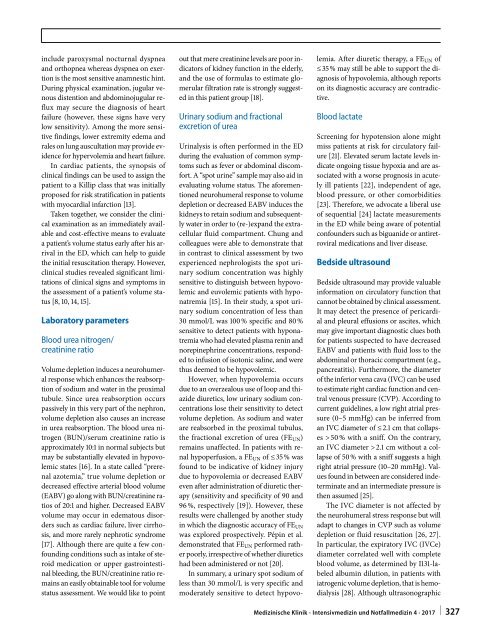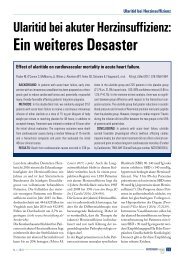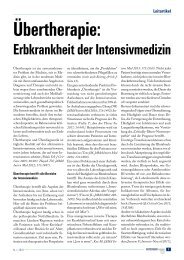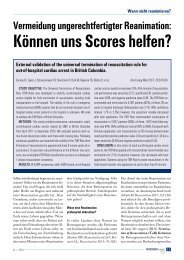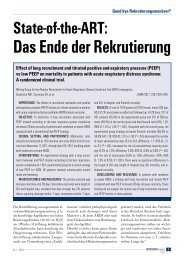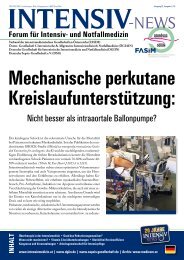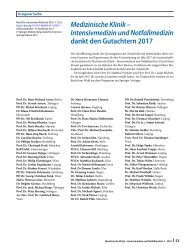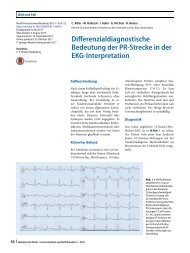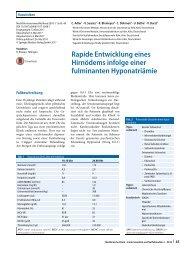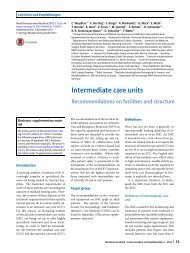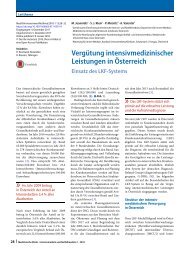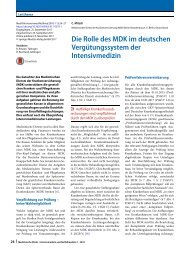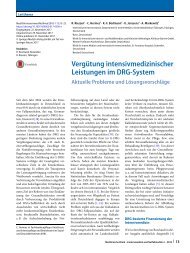08 Assessment of volume status and fluid responsiveness in the emergency department
Create successful ePaper yourself
Turn your PDF publications into a flip-book with our unique Google optimized e-Paper software.
<strong>in</strong>clude paroxysmal nocturnal dyspnea<br />
<strong>and</strong> orthopnea whereas dyspnea on exertion<br />
is <strong>the</strong> most sensitive anamnestic h<strong>in</strong>t.<br />
Dur<strong>in</strong>g physical exam<strong>in</strong>ation, jugular venous<br />
distention <strong>and</strong> abdom<strong>in</strong>ojugular reflux<br />
may secure <strong>the</strong> diagnosis <strong>of</strong> heart<br />
failure (however, <strong>the</strong>se signs have very<br />
low sensitivity). Among <strong>the</strong> more sensitive<br />
f<strong>in</strong>d<strong>in</strong>gs, lower extremity edema <strong>and</strong><br />
rales on lung auscultation may provide evidence<br />
for hypervolemia <strong>and</strong> heart failure.<br />
In cardiac patients, <strong>the</strong> synopsis <strong>of</strong><br />
cl<strong>in</strong>ical f<strong>in</strong>d<strong>in</strong>gs can be used to assign <strong>the</strong><br />
patient to a Killip class that was <strong>in</strong>itially<br />
proposed for risk stratification <strong>in</strong> patients<br />
with myocardial <strong>in</strong>farction [13].<br />
Taken toge<strong>the</strong>r, we consider <strong>the</strong> cl<strong>in</strong>ical<br />
exam<strong>in</strong>ation as an immediately available<br />
<strong>and</strong> cost-effective means to evaluate<br />
a patient’s <strong>volume</strong> <strong>status</strong> early after his arrival<br />
<strong>in</strong> <strong>the</strong> ED, which can help to guide<br />
<strong>the</strong> <strong>in</strong>itial resuscitation <strong>the</strong>rapy. However,<br />
cl<strong>in</strong>ical studies revealed significant limitations<br />
<strong>of</strong> cl<strong>in</strong>ical signs <strong>and</strong> symptoms <strong>in</strong><br />
<strong>the</strong> assessment <strong>of</strong> a patient’s <strong>volume</strong> <strong>status</strong><br />
[8, 10, 14, 15].<br />
Laboratory parameters<br />
Blood urea nitrogen/<br />
creat<strong>in</strong><strong>in</strong>e ratio<br />
Volume depletion <strong>in</strong>duces a neurohumeral<br />
response which enhances <strong>the</strong> reabsorption<br />
<strong>of</strong> sodium <strong>and</strong> water <strong>in</strong> <strong>the</strong> proximal<br />
tubule. S<strong>in</strong>ce urea reabsorption occurs<br />
passively <strong>in</strong> this very part <strong>of</strong> <strong>the</strong> nephron,<br />
<strong>volume</strong> depletion also causes an <strong>in</strong>crease<br />
<strong>in</strong> urea reabsorption. The blood urea nitrogen<br />
(BUN)/serum creat<strong>in</strong><strong>in</strong>e ratio is<br />
approximately 10:1 <strong>in</strong> normal subjects but<br />
may be substantially elevated <strong>in</strong> hypovolemic<br />
states [16]. In a state called “prerenal<br />
azotemia,” true <strong>volume</strong> depletion or<br />
decreased effective arterial blood <strong>volume</strong><br />
(EABV) go along with BUN/creat<strong>in</strong><strong>in</strong>e ratios<br />
<strong>of</strong> 20:1 <strong>and</strong> higher. Decreased EABV<br />
<strong>volume</strong> may occur <strong>in</strong> edematous disorders<br />
such as cardiac failure, liver cirrhosis,<br />
<strong>and</strong> more rarely nephrotic syndrome<br />
[17]. Although <strong>the</strong>re are quite a few confound<strong>in</strong>g<br />
conditions such as <strong>in</strong>take <strong>of</strong> steroid<br />
medication or upper gastro<strong>in</strong>test<strong>in</strong>al<br />
bleed<strong>in</strong>g, <strong>the</strong> BUN/creat<strong>in</strong><strong>in</strong>e ratio rema<strong>in</strong>s<br />
an easily obta<strong>in</strong>able tool for <strong>volume</strong><br />
<strong>status</strong> assessment. We would like to po<strong>in</strong>t<br />
out that mere creat<strong>in</strong><strong>in</strong>e levels are poor <strong>in</strong>dicators<br />
<strong>of</strong> kidney function <strong>in</strong> <strong>the</strong> elderly,<br />
<strong>and</strong> <strong>the</strong> use <strong>of</strong> formulas to estimate glomerular<br />
filtration rate is strongly suggested<br />
<strong>in</strong> this patient group [18].<br />
Ur<strong>in</strong>ary sodium <strong>and</strong> fractional<br />
excretion <strong>of</strong> urea<br />
Ur<strong>in</strong>alysis is <strong>of</strong>ten performed <strong>in</strong> <strong>the</strong> ED<br />
dur<strong>in</strong>g <strong>the</strong> evaluation <strong>of</strong> common symptoms<br />
such as fever or abdom<strong>in</strong>al discomfort.<br />
A “spot ur<strong>in</strong>e” sample may also aid <strong>in</strong><br />
evaluat<strong>in</strong>g <strong>volume</strong> <strong>status</strong>. The aforementioned<br />
neurohumeral response to <strong>volume</strong><br />
depletion or decreased EABV <strong>in</strong>duces <strong>the</strong><br />
kidneys to reta<strong>in</strong> sodium <strong>and</strong> subsequently<br />
water <strong>in</strong> order to (re-)exp<strong>and</strong> <strong>the</strong> extracellular<br />
<strong>fluid</strong> compartment. Chung <strong>and</strong><br />
colleagues were able to demonstrate that<br />
<strong>in</strong> contrast to cl<strong>in</strong>ical assessment by two<br />
experienced nephrologists <strong>the</strong> spot ur<strong>in</strong>ary<br />
sodium concentration was highly<br />
sensitive to dist<strong>in</strong>guish between hypovolemic<br />
<strong>and</strong> euvolemic patients with hyponatremia<br />
[15]. In <strong>the</strong>ir study, a spot ur<strong>in</strong>ary<br />
sodium concentration <strong>of</strong> less than<br />
30 mmol/L was 100 % specific <strong>and</strong> 80 %<br />
sensitive to detect patients with hyponatremia<br />
who had elevated plasma ren<strong>in</strong> <strong>and</strong><br />
norep<strong>in</strong>ephr<strong>in</strong>e concentrations, responded<br />
to <strong>in</strong>fusion <strong>of</strong> isotonic sal<strong>in</strong>e, <strong>and</strong> were<br />
thus deemed to be hypovolemic.<br />
However, when hypovolemia occurs<br />
due to an overzealous use <strong>of</strong> loop <strong>and</strong> thiazide<br />
diuretics, low ur<strong>in</strong>ary sodium concentrations<br />
lose <strong>the</strong>ir sensitivity to detect<br />
<strong>volume</strong> depletion. As sodium <strong>and</strong> water<br />
are reabsorbed <strong>in</strong> <strong>the</strong> proximal tubulus,<br />
<strong>the</strong> fractional excretion <strong>of</strong> urea (FE UN )<br />
rema<strong>in</strong>s unaffected. In patients with renal<br />
hypoperfusion, a FE UN <strong>of</strong> ≤ 35 % was<br />
found to be <strong>in</strong>dicative <strong>of</strong> kidney <strong>in</strong>jury<br />
due to hypovolemia or decreased EABV<br />
even after adm<strong>in</strong>istration <strong>of</strong> diuretic <strong>the</strong>rapy<br />
(sensitivity <strong>and</strong> specificity <strong>of</strong> 90 <strong>and</strong><br />
96 %, respectively [19]). However, <strong>the</strong>se<br />
results were challenged by ano<strong>the</strong>r study<br />
<strong>in</strong> which <strong>the</strong> diagnostic accuracy <strong>of</strong> FE UN<br />
was explored prospectively. Pép<strong>in</strong> et al.<br />
demonstrated that FE UN performed ra<strong>the</strong>r<br />
poorly, irrespective <strong>of</strong> whe<strong>the</strong>r diuretics<br />
had been adm<strong>in</strong>istered or not [20].<br />
In summary, a ur<strong>in</strong>ary spot sodium <strong>of</strong><br />
less than 30 mmol/L is very specific <strong>and</strong><br />
moderately sensitive to detect hypovolemia.<br />
After diuretic <strong>the</strong>rapy, a FE UN <strong>of</strong><br />
≤ 35 % may still be able to support <strong>the</strong> diagnosis<br />
<strong>of</strong> hypovolemia, although reports<br />
on its diagnostic accuracy are contradictive.<br />
Blood lactate<br />
Screen<strong>in</strong>g for hypotension alone might<br />
miss patients at risk for circulatory failure<br />
[21]. Elevated serum lactate levels <strong>in</strong>dicate<br />
ongo<strong>in</strong>g tissue hypoxia <strong>and</strong> are associated<br />
with a worse prognosis <strong>in</strong> acutely<br />
ill patients [22], <strong>in</strong>dependent <strong>of</strong> age,<br />
blood pressure, or o<strong>the</strong>r comorbidities<br />
[23]. Therefore, we advocate a liberal use<br />
<strong>of</strong> sequential [24] lactate measurements<br />
<strong>in</strong> <strong>the</strong> ED while be<strong>in</strong>g aware <strong>of</strong> potential<br />
confounders such as biguanide or antiretroviral<br />
medications <strong>and</strong> liver disease.<br />
Bedside ultrasound<br />
Bedside ultrasound may provide valuable<br />
<strong>in</strong>formation on circulatory function that<br />
cannot be obta<strong>in</strong>ed by cl<strong>in</strong>ical assessment.<br />
It may detect <strong>the</strong> presence <strong>of</strong> pericardial<br />
<strong>and</strong> pleural effusions or ascites, which<br />
may give important diagnostic clues both<br />
for patients suspected to have decreased<br />
EABV <strong>and</strong> patients with <strong>fluid</strong> loss to <strong>the</strong><br />
abdom<strong>in</strong>al or thoracic compartment (e.g.,<br />
pancreatitis). Fur<strong>the</strong>rmore, <strong>the</strong> diameter<br />
<strong>of</strong> <strong>the</strong> <strong>in</strong>ferior vena cava (IVC) can be used<br />
to estimate right cardiac function <strong>and</strong> central<br />
venous pressure (CVP). Accord<strong>in</strong>g to<br />
current guidel<strong>in</strong>es, a low right atrial pressure<br />
(0–5 mmHg) can be <strong>in</strong>ferred from<br />
an IVC diameter <strong>of</strong> ≤ 2.1 cm that collapses<br />
> 50 % with a sniff. On <strong>the</strong> contrary,<br />
an IVC diameter > 2.1 cm without a collapse<br />
<strong>of</strong> 50 % with a sniff suggests a high<br />
right atrial pressure (10–20 mmHg). Values<br />
found <strong>in</strong> between are considered <strong>in</strong>determ<strong>in</strong>ate<br />
<strong>and</strong> an <strong>in</strong>termediate pressure is<br />
<strong>the</strong>n assumed [25].<br />
The IVC diameter is not affected by<br />
<strong>the</strong> neurohumeral stress response but will<br />
adapt to changes <strong>in</strong> CVP such as <strong>volume</strong><br />
depletion or <strong>fluid</strong> resuscitation [26, 27].<br />
In particular, <strong>the</strong> expiratory IVC (IVCe)<br />
diameter correlated well with complete<br />
blood <strong>volume</strong>, as determ<strong>in</strong>ed by I131-labeled<br />
album<strong>in</strong> dilution, <strong>in</strong> patients with<br />
iatrogenic <strong>volume</strong> depletion, that is hemodialysis<br />
[28]. Although ultrasonographic<br />
Mediz<strong>in</strong>ische Kl<strong>in</strong>ik - Intensivmediz<strong>in</strong> und Notfallmediz<strong>in</strong> 4 · 2017 |<br />
327


